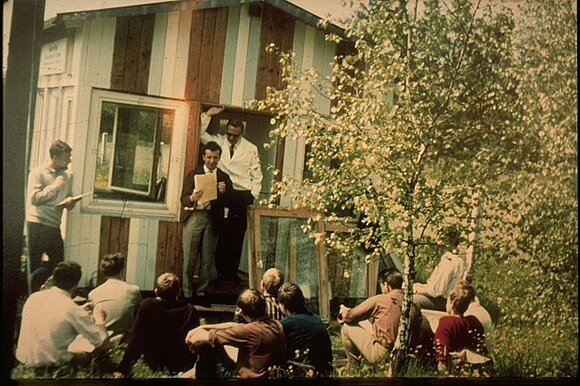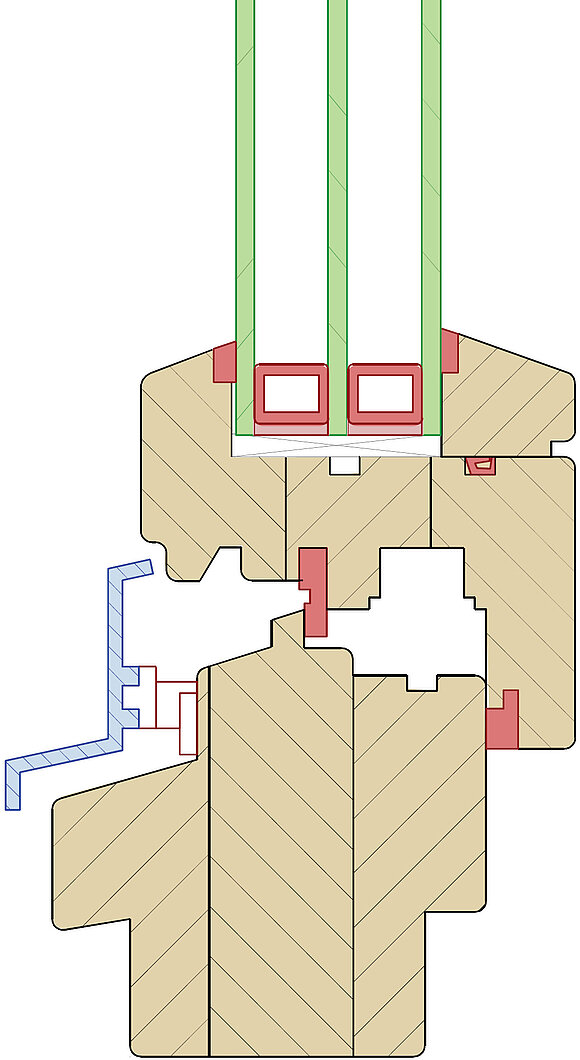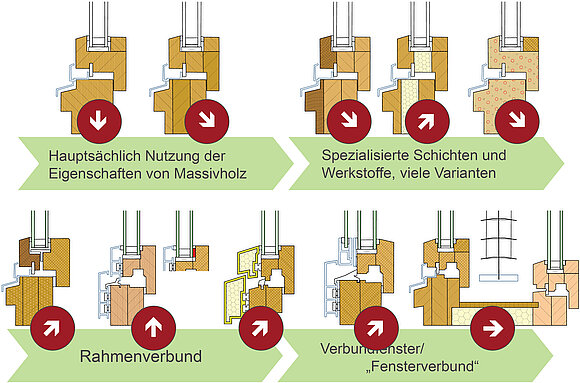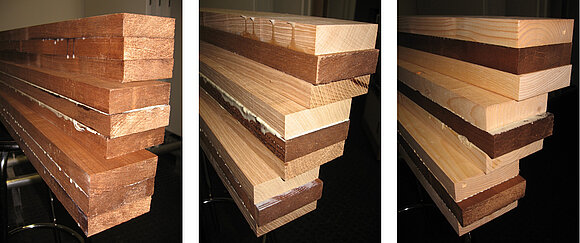Reading time: 1 minute
Das Institut für Fenstertechnik e.V. (ift Rosenheim) feiert 2016 sein 50-jähriges Be-stehen. Unter dem Motto „ift Rosenheim – 50 Jahre im Dienst der Branche“ wird in einer 10-teiligen Fachartikelserie die technische Entwicklung vorgestellt. Die einzel-nen Beiträge beziehen sich auf Zeitfenster von 5 Jahren ab der Institutsgründung. Sie ermöglichen einen kurzen Blick ins „damalige“ Zeitgeschehen, greifen als Schwer-punkt ein wegweisendes Forschungsprojekt aus diesem Zeitfenster auf, erläutern kurz Ziele, Inhalte sowie Ergebnisse und veranschaulichen dann die weitere Entwick-lung sowie deren Auswirkungen auf die Branche und den aktuellen Stand der Tech-nik.
Significant events (1966 – 1970):
The phase of reconstruction in the Federal Republic of Germany just came to an end as the Insitut für Fenstertechnik e.V. was founded in 1966. This time was characterized by the quantitative satisfaction of demand in house building. The further looming orientation towards higher quality in house building fully covers the aim of the institute. The secure basis for high-quality window, door and facade technology was created with additional work and the conscientious publishing of the results which have a leading position in the international standard.

Building Inspector Erich Seifert and Josef Schmid with students – a lively lecture in the country
Year | Current affairs |
1966 |
|
1967 |
|
1968 |
|
1969 | - Neil Armstrong is the first person to walk on the Moon at mission Apollo 11 - The ‘Woodstock Music and Art Festival’ is the musical highlight of the US-american hippie movement with more than 400,000 visitors |
1970 | - A new policy of détente between Federal Republic of Germany and East Germany by reciprocal visits of Federal Chancellor Willy Brandt and prime minister of the GDR Willy Stoph - Liberation of Andreas Baader from the prison becomes the birth of the radical union ‘Red Army Faction’ (RAF) - The legendary cult band ‘The Beatles’ separates |
Timber window – the first research project

Situation at the moment of the establishment of the institute
The establishment of the Institute für Fenstertechnik e.V. (ift Rosenheim) in 1966 was no coincidence. It coincides with the critical 60s for timber windows and the logical consequence of the accumulation of problems from the entire application area of timber windows. The existing window technology was characterised by the traditional knowledge and experience as well as the strong emphasis of more rational mass production.
At that time, technical codes of rules were already available that specified the property values for different window designs. In DIN 4701 dated January 1959, for Example, tables already exist where functional values for thermal studies are given, like Table 3 ‘thermal transmittance k for windows and doors’ or Table 4a ‘permeability of joints a per m joint length for windows and doors impeccable execution and normal joint dimensions’.
But what was the meaning of ‘impeccable execution’? The first challenges were created for ift. Specifications depending on the expecting load were specified. Evidences for achieving the classifications had to be enabled with justifiable efforts via tables or tests. Statements regarding properties of serial products had to be ensured by static quality controls.
Already 2 years after establishing ift, results of the examinations of the research project ‘damages on timber windows’ lead to the first research report. One year later, the paper ‘examination on timber windows’ as well as the brochure ‘timber window’ with specifications to all characteristics of timber windows [1, 2, 3] followed.
Definition of task and aim of the first research projects
‘The service life of the component window was usually determined by the change of architecture. The natual ageing was almost nocht existing.’ These were arguments in the problem definiton of the first ift-research reports. In the previous years, premature ageing of timber windows has been determined to an increasing extent by the infestation of wood-destroying fungi. The planned tasks should demonstrate the causes of the frequently recognized moisture penetration and the wood-destruction resulting from it. New and to the state of the production technology adapted processing guideline should be set up. The work comprises the following issues
– Determination of load bearing cross-sections
- Water tightness
– Definition of groups for gluing
– Glazing (final sealing-closure glass to frame)
– Temperature load by coloured coating
Results of research projects
Reasons for the high moisture enrichments were clearly seen in the constructive and processing-technical area (ingress of moisture, e.g. via glazing, attachment to structure and open gluing), as well as excessive demand of the material and building-physical mistakes. In addition, examinations carried out at the same time, which were not finished by the time of the report date, assumed influences of execution of construction work, type of installation and mounting direction. Futhermore, clear connections with the used coating system are verified. Already at that time urgently formulated request was interesting: ‘The research center conceives the preparation of a extensive DIN-standard “Window” as an aim of all tasks. ...’.

In 1969, ift Rosenheim could give the industry basic knowledge in terms of various tables and elaborations as concrete results from the research projects:
- Tables for determination of necessary moments of inertia for wood
- Table for determination of cross-sections for mullions and transoms
- Table for determination of category of duty for water tightness
- Table ‘Recommendation of maximum sash size depending on the category of duty for water tightness’
- Table for assessment of category of duty for glazing of windows
- Recommendation for tender of timber windows
Most of these valuable documents for the construction practice were developed and are still valid as indispensable condition for construction and production of functional windows.
ift-research project from 1966 until 1970 (public)
1968 defects on timber windows
1969 inspection on timber windows
1969 timber window; manual for construction and production of timber windows
1970 inspection regarding performance of glued frame joints at climatic impacts
1970 inspection regarding reasons of damages on timber windows by wood-destroying fungi
1970 inspection regarding staying power of plywood doors at climatic load and its resistance at mechanical load (1. interim report
The consequence: DIN 68121 determines the appearance of the timber window
Almost all basics for timber windows have been described. The DIN 68121-1 [6] and -2 have been published in 1973 and resulted almost completely from the before mentioned research work. Many figures, tables and diagrams have been only copied. Further guidelines regarding lamination, surface coating, construction of glazing, etc. pioneered the still relevant principles of the window design which have to be applied not only for timber windows but also for all other frame materials and types of construction.
The window manufacturer have gratefully accepted these building instructions; from now on it came to an improvement of the processing quality as well as the achieved technical characteristics.

The picture changed only in the 1990s. Hence, it came to a revised version of DIN 68121 in 1993. By the constellation of
- increasing specifications in structural engineering regarding thermal insulation, airtightness, low construction periods and high humidity levels during the construction phase
- Elimination of sturdy tropical woods and replacement by domestic, less suitable wood species
- lack of willingness of owners to intensify the maintenance of painting
- tricky architectural drafts with exposed bay windows, conservatories, etc., for pure timber windows
- individual changes and developments of the standardised details, but also
- the age-related elimination of experts for timber windows from the first hour
the damages increased which costs the timber window lastingly market shares (Fig. 4).
In addition, all timber window constructions looked practically identical; the rigid standardization had developed to a disadvantage to other frame materials.
Timber window as of 2016
In 2015, in the tender still contains ‘IV 68 according to DIN 68121“ for the description of timber windows. Only general details as drainage channels, edge rounding, geometry of drip projections, etc. are relevant for the present time from the basics that are already 40 years old. The European classes and performance characteristics according to EN‑14351‑1 [8] have replaced durability classes, type-size diagrames and Co.
The thermal optimisation of the timber windows were particularly in focus for the last 20 years. In addition, the precarious areas of the constructions were adapted regarding the condensation water formation. The market asks for modern timber windows with characteristics that have developed to the state of the art as in Fig. 5.
- Frame thickness of more than 68 mm for admission of modern glazing and for improvement of the Uf-values.
- Triple insulation glazing with warm edge
- Thermally optimised drainage system
- Two continuous sealing planes at rebate between frame and sash
- Narrow projected width for reduction of the frame area at the window
- Large selection of timber types, profile structures with insulating material, use of remunerated woods
- Tight glazing rebate on room side with specified sealing of glazing beads to frame


As development trend of the last years can be noted a defined basic ventilation, minimum heat loss, thermal insulation during summer, safety-related properties (burglar resistance, as well as safety in use) and also the comfort when handling the window. All current trends (Fig. 6) show that the flexible handling of the material wood is the way in to the future of timber windows.
The trend moves away from pure timber windows and towards timber metal windows, new types of glazing with integral leaves (Fig. 8) and integrated shading device at coupled windows. Besides, the reduced maintenance cost plays a big role.

(left: only thermally modified poplar; centre: thermally modified poplar and oak; right: thermally modified poplar and spruce) [10]

- Projected width is determined by the frame member – small frame area
- Insulation of frame for the Uf-value
- The wooden area in the weathering can be minimized with excessive insulation of the frame during installation
- Glass can be applied with crimping
Summary
In the early years of ift Rosenheim, a variety of basics have been developed with the research work and standardisation work for timber windows, which matter a lot for the complete fenestration technology up to now.
The current technology for timber windows clearly leaves DIN 68121. Great potential for development surmises of innovative constructions and/or glazing systems as well as e.g. integral windows. Advantages from design-oriented as well as from thermal point of view are the results of minimizing the face widths. Furthermore, when developing new window systems, it is important to have an ongoing coordination with all participating subcontractors (e.g. hardware, sealing profile and tool manufacturers) at the earliest possible date of the development phase. Hence, the oldest frame material for windows is fit for the future.
Literature
- Seifert, E.; Schmid, J.; Hofmann, S.:
Defects on timber windows
Research report of Instituts für Fenstertechnik e.V., Rosenheim 1968 - Seifert, E.; Schmid, J.; Ermschel, D.:
Inspection on timber windows
Research report of Instituts für Fenstertechnik e.V., Rosenheim 1969 - Seifert, E.; Schmid, J:
Timber window; manual for construction and production of timber windows
Editor: Arbeitskreis Holzfenster e.V., Gießen 1969 - DIN 4701:1959-01
Heating; Rule for the calculation of the heat requirement of buildings - 25 years Institut für Fenstertechnik e.V.; An overview.
Institut für Fenstertechnik e.V., Rosenheim 1991 - DIN 68121-1:1973-03
Timber profiles for windows; Side-hinged window, tilt and turn window and tilt-only window - E DIN 68121-2:1986-10:
Timber profiles for windows and french windows - General technical details - EN 14351-1:2006+A1:2010:
Windows and doors – Product standard, performance characteristics – Part 1: Windows and external pedestrian doorsets without resistance to fire and/or smoke leakage characteristics.
Beuth GmbH, Berlin - Leuschner, I.; von Houwald, B.:
Fundamentals of construction for window, door and façade elements of composite material and wood – Part 2.
Research report of ift Rosenheim, 2008 - Bliemetsrieder, B.; Sack, N.:
Timber window 2012; Lasting and effective optimisation of timber profiles to reach the specifications of the Energy Saving Regulations 2012.
Research report of ift Rosenheim, 2011
These publications are available in German only (except [8]).



